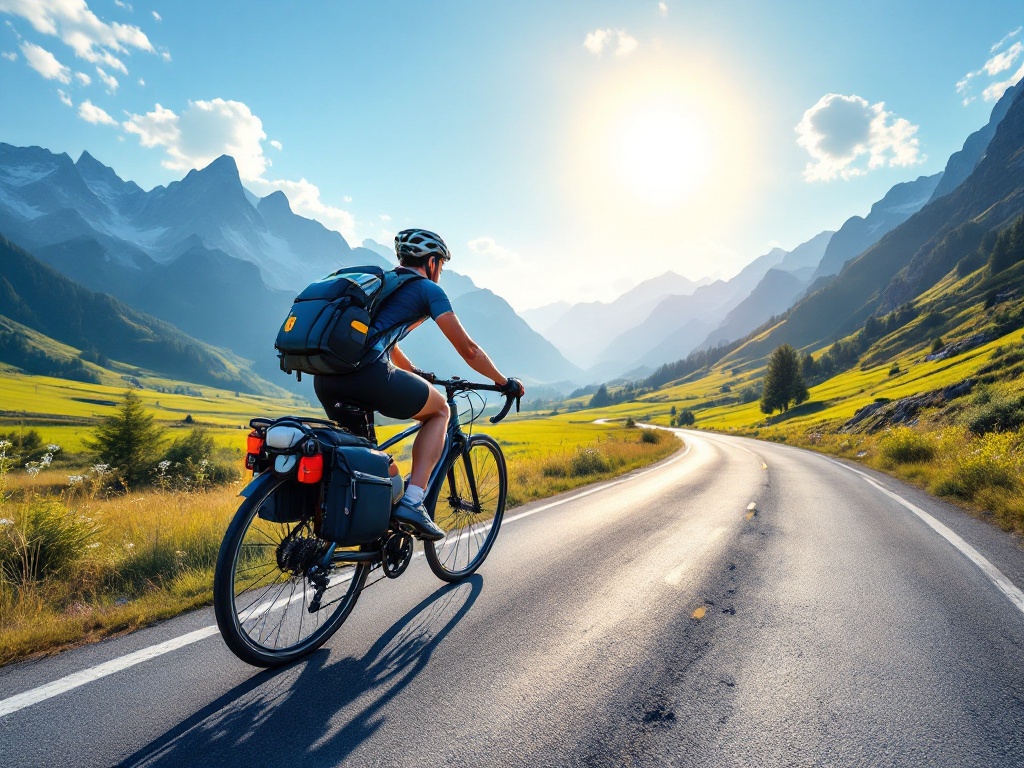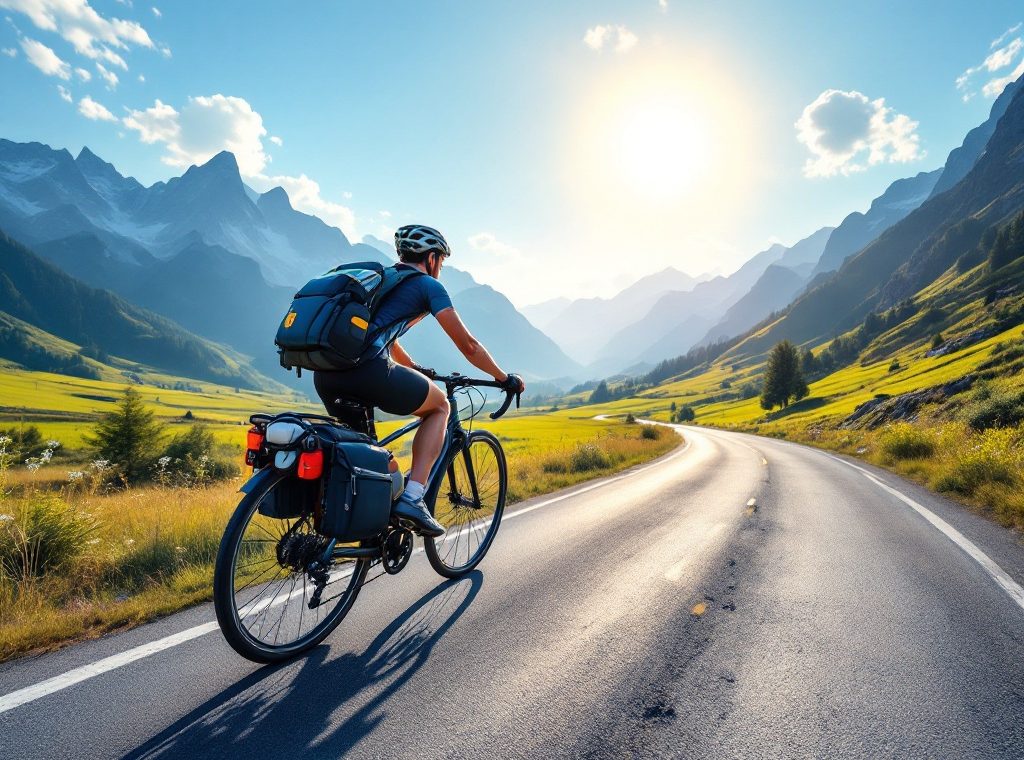Essential Packing Guide for Cyclists Traveling Internationally
Dream of cycling through breathtaking landscapes abroad? This guide provides essential preparation steps for a smooth international cycling trip. Learn how to research routes, pack efficiently, and handle bike transport. Discover key safety advice, health precautions, and important document management. Prepare for your adventure and pedal towards unforgettable experiences. Start planning your dream cycling trip today!
Important information

- Research your destination: Study routes, weather, local laws, and cultural customs.
- Prepare your bike: Ensure it’s in top condition, pack it according to airline rules, and bring essential repair tools.
- Pack smart: Bring adaptable clothing, safety gear (helmet, lights), first-aid kit, and navigation tools.
- Secure travel documents: Ensure your passport is valid, obtain necessary visas, and carry copies of important documents. Get travel insurance that covers cycling incidents.
- Plan for on-the-road needs: Pack hydration supplies, snacks, and consider nutrition for longer rides.
Preparation for International Cycling Travel
Planning an international cycling trip requires careful preparation. Research your chosen destination thoroughly, including local weather patterns and cycling routes. Ensure your bike is in top condition for a trouble-free journey. Familiarize yourself with local cycling laws and be prepared for challenges such as language barriers and cultural differences. Pack adaptable clothing suitable for changing weather; a detailed packing list is essential. Travel insurance is also advisable. Most importantly, enjoy the adventure.
Research your destination. Investigate local weather forecasts and suitable cycling routes.
Prepare your bicycle. Ensure your bike is in excellent working order for a smooth trip.
Learn local regulations. Familiarize yourself with cycling rules and be aware of potential language barriers and cultural differences.
Pack appropriately. Bring versatile clothing for various weather conditions and create a comprehensive packing list.
Get travel insurance. Protect yourself against unforeseen circumstances with travel insurance.
Research and Planning
Research your destination’s routes and familiarize yourself with local customs and regulations.
Map a detailed itinerary, noting distances, elevation changes, and planned rest stops.
Check the weather forecast and pack accordingly.
Anticipate potential challenges like language barriers and visa requirements.
Pre-book accommodations along your route for a seamless and enjoyable journey.
Booking Flights and Bike Transport
Book your flights early to secure your seat and a spot for your bike.
Pre-book bike transport with the airline due to limited space.
Check each airline’s specific luggage restrictions, including size and weight limits.
Pack your bicycle in a suitable bike bag or case to protect it from travel damage.
Travel Insurance and Health Preparation
Before embarking on your journey, confirm your travel insurance covers cycling-related incidents and emergencies. A well-maintained bike is essential, so schedule a tune-up beforehand. Remember to pack any necessary prescription medications and a basic first-aid kit for unexpected situations.
Confirm your travel insurance covers cycling-related incidents and emergencies.
Schedule a tune-up for your bike.
Pack any necessary prescription medications and a basic first-aid kit.
Travel Documents and Important Items
Safeguard essential travel documents, especially for international cycling adventures. A valid passport is a must. Visas may be necessary depending on your destination. Secure travel insurance and prepare a copy of your itinerary, including accommodation details and emergency contacts.
Photocopy your passport and other crucial documents. This offers valuable protection against loss or theft. Investigate whether your bicycle requires specific customs documentation. Store all documents in a waterproof pouch, and keep travel confirmations for flights and accommodations readily accessible.
Before departure, confirm your passport’s expiration date, as many countries mandate a validity extending six months beyond your trip. Research each country’s specific entry requirements to ensure compliance.
Organize all your confirmations and tickets for flights, trains, and accommodations. While electronic copies offer convenient access, printed backups provide a reliable alternative.
Important Travel Documents
Planning an international cycling adventure requires careful preparation, especially regarding travel documents. Ensure you have a valid passport and any necessary visas. Travel insurance is crucial for unforeseen circumstances. A detailed itinerary including emergency contacts and accommodation details is highly recommended. Photocopies of your passport and other important documents provide backup if the originals are lost or stolen. If bringing your bicycle, research any specific customs documents required by your destination country. Finally, organize and protect all documents in a waterproof pouch.
Passport and Visas: Secure a valid passport and any necessary visas well in advance of your trip.
Travel Insurance: Obtain comprehensive travel insurance to cover medical emergencies, lost belongings, and other unexpected events.
Detailed Itinerary: Create a detailed itinerary with emergency contacts, accommodation information, and planned routes.
Document Photocopies: Make photocopies of your passport, visas, and other important documents. Store them separately from the originals.
Bicycle Customs: Research any specific customs documents required for transporting your bicycle to your destination country.
Waterproof Pouch: Organize and protect all your essential documents in a waterproof pouch to keep them safe from the elements.
Ensuring Passport Validity
For a smooth trip, ensure your passport remains valid for three to six months beyond your return date. This precaution avoids potential travel complications.
Travel Confirmations and Tickets
Keep your travel documents and tickets in your carry-on bag for easy access during your trip.
Comprehensive Packing List for Cyclists
Planning an international cycling adventure requires a comprehensive packing list. Consider your trip’s duration, destination climate, and terrain.Essential cycling gear includes a helmet, cycling shoes, and padded shorts for comfort. Gloves provide grip and protection, while a waterproof jacket shields you from rain.Pack versatile, lightweight clothing. A multi-tool, tire repair kit with levers and spare tubes, and a pump are crucial. Don’t forget a first-aid kit, sunscreen, insect repellent, toiletries, and a travel adapter. Pack snacks and a refillable water bottle. Review your airline’s luggage restrictions.
Bicycle Preparation
Ensure your bicycle is in top condition before departure. Pack your helmet and cycling shoes. Padded shorts enhance comfort. Gloves improve grip and hand protection. A repair kit with a multi-tool, tire levers, and spare tubes is essential. A pump is vital for proper tire pressure. Lights are crucial for visibility, especially at night. A sturdy bike lock protects your bicycle. Consider panniers or a handlebar bag.
Weather Considerations
Research your destination’s climate and pack layers. Rain gear is essential. Consider insulation for cold and sun protection for sunny days. Arm and leg warmers provide extra warmth. Lightweight, breathable fabrics are ideal for warmer climates. Be prepared for unexpected weather changes.
Creating a Tailored Packing List
Pack your cycling essentials: bike, helmet, cycling shoes, and padded shorts. Choose versatile, lightweight clothing adaptable to changing weather. A waterproof jacket and gloves are crucial for rain. Essential tools include a multi-tool, tire repair kit, and pump.
Safety and health items are vital:
- first-aid kit,
- sunscreen,
- insect repellent.
Enhance your comfort and preparedness:
- toiletries,
- travel adapter,
- snacks,
- water bottle.
Check airline regulations before traveling.
Weather Considerations for Packing
Packing for a cycling trip requires adaptable clothing layers. Consider these essential items:
- Arm and leg warmers: offer versatile temperature control.
- Waterproof jacket: a must-have for unexpected showers.
- Breathable base layers: key for comfort in fluctuating conditions.
Warm Weather Destinations
- Prioritize lightweight, breathable fabrics.
- Pack crucial sun protection.
Cool Weather Destinations
- Pack thermal layers.
- Include an insulated jacket.
Don’t forget these important accessories:
- Gloves.
- Cap.
- Appropriate footwear for changing weather.
Essential Bike Gear and Accessories
Essential cycling gear starts with a well-maintained bicycle, a helmet, and cycling shoes. Padded shorts and moisture-wicking jerseys significantly enhance riding comfort.
Safety is key. Essential items include lights and a lock. A GPS device aids navigation, while a small first-aid kit addresses minor injuries.
Don’t forget a repair kit containing a multi-tool, tire levers, spare tubes, and a pump for roadside emergencies.
Beyond cycling gear, pack personal items like toiletries and casual clothes for post-ride relaxation. If traveling abroad, a travel adapter is invaluable. These additions will enhance your overall trip experience.
Bike Preparation and Packing
Inspect your bike thoroughly before traveling. Ensure brakes, gears, and tires are in top condition, and lubricate the chain for optimal performance.
Careful disassembly is key for packing. Remove the pedals, front wheel, and possibly the handlebars. Secure everything in a travel case or box with ample padding to prevent damage. Remember to check airline bike transport regulations, as they differ.
Pack essential tools like a multi-tool, tire levers, a pump, spare tubes, a patch kit, and a chain link for common roadside repairs, such as fixing a flat. Being prepared will ensure a smoother journey.
Bike Maintenance Before Travel
Preparing your bicycle for an international trip requires a thorough check-up. Carefully inspect your brakes, gears, and tires for any damage. A well-maintained bike is essential for a smooth journey. Clean your bicycle thoroughly and lubricate the chain. You may need to disassemble your bike for packing, so follow airline regulations. Pack essential tools like a multi-tool, tire levers, a spare tube, and a small pump for roadside repairs.
Give your bicycle a comprehensive check-up, including inspecting brakes, gears, and tires.
Clean your bicycle thoroughly and lubricate the chain for optimal performance.
If disassembling your bike for packing, adhere to airline regulations.
Pack essential tools: a multi-tool, tire levers, a spare tube, and a small pump.
Packing Your Bike for Travel
Disassembling your bike for travel involves a few key steps. First, remove essential components such as the fork, handlebars, and seatpost. Next, protect the frame using foam padding or bubble wrap. Finally, consider using a bike-specific bag or case for optimal protection during transit.
Tools and Spare Parts to Include
Pack a multi-tool, essential for any cyclist.
Include tire levers and a mini-pump or CO2 inflator for roadside repairs.
Bring spare tubes, a patch kit, and a chain breaker to address common mechanical problems.
Add a small first-aid kit for minor injuries.
Remember any bike-specific tools you might need.
These preparations will ensure a safe and enjoyable ride.
Cycling Clothing and Personal Items
Cycling Gear
For enjoyable rides, choose moisture-wicking jerseys and padded shorts. Dress in lightweight, breathable layers to adapt to changing weather. A waterproof jacket is essential for rainy days. Arm and leg warmers offer extra warmth in cooler temperatures. Prioritize safety with a helmet and cycling gloves.
Off-Bike Essentials
Pack comfortable shoes suitable for both cycling and walking. Casual clothes are essential for exploring. Versatile outfits will prepare you for any activity.
Personal Items
- Toiletries (toothbrush, toothpaste, shampoo, soap),
- Medications,
- A small first aid kit,
- A travel adapter for electronics,
- A portable charger,
- A reusable water bottle,
- Your passport and any required visas.
Weather-Appropriate Cycling Clothing
Pack moisture-wicking jerseys and padded cycling shorts for a comfortable ride. Lightweight, breathable layers are essential for adapting to changing weather conditions. A waterproof jacket is crucial for unexpected rain. For cooler temperatures, arm and leg warmers provide added warmth.
Don’t forget protective gear like a helmet, cycling gloves, and comfortable cycling shoes to enhance your performance and safety. If your cycling trip spans different climates, pack accordingly. Thermal layers are ideal for cold weather, while sun-protective clothing is vital in hotter climates. A cap or bandana will help manage sweat and shield you from the sun.
Casual Wear and Off-Bike Essentials
When packing for your international cycling adventure, prioritize comfortable clothing, such as shirts, pants, and comfortable shoes for relaxing moments off the bike. Don’t forget essential toiletries for personal hygiene.
Personal Items and Toiletries
Toiletries: toothbrush, toothpaste, shampoo, and soap.
Medications: pack any necessary medications and a small first aid kit.
Electronics: travel adapter and portable charger.
Documents: passport and any required visas.
Space-saving items: lightweight towel and reusable water bottle.
Important tip: pack smart and travel light.
On-the-Road Essentials
Hydration and Nutrition
Staying properly hydrated and fueled is essential for cyclists. Carry a reusable water bottle and plan refill stops along your route. For longer rides, pack energy bars, gels, or snacks to meet your dietary needs. Researching food options available en route is also a good idea.
Safety Precautions
Always wear a well-fitted helmet and use lights for visibility. For navigation, use a GPS device or smartphone app with pre-downloaded maps.
First-Aid Kit Essentials
A well-stocked first-aid kit is crucial for any cyclist.
- Adhesive bandages,
- antiseptic wipes,
- gauze pads,
- medical tape,
- pain relievers,
- blister treatments.
Also include:
- a thermometer,
- allergy medication,
- personal prescriptions,
- emergency contact information.
Hydration and Nutrition
Staying hydrated is essential, so carry a refillable water bottle. Pack portable snacks like energy bars, nuts, and dried fruit for quick energy boosts. Electrolyte supplements are particularly helpful in hot weather. Planning your meals with balanced carbohydrates, proteins, and healthy fats is key for sustained energy. Researching local food options beforehand allows you to discover nutritious meals and experience the local cuisine. For longer rides, hydration packs are invaluable for increasing your water capacity. Instead of three large meals, consider eating smaller portions more frequently to maintain your energy levels throughout your journey. Here’s a helpful list to ensure you’re adequately prepared:
- Hydration: Carry a refillable water bottle and consider a hydration pack for longer rides.
- Snacks: Pack portable snacks like energy bars, nuts, and dried fruit.
- Electrolytes: Use electrolyte supplements, especially in hot weather.
- Meal Planning: Plan balanced meals with carbohydrates, proteins, and healthy fats.
- Local Cuisine: Research local food options in advance.
- Eating Frequency: Eat smaller portions more frequently for sustained energy.
Safety Gear and Navigation Tools
Prioritize safety by wearing a well-fitted helmet and bright clothing, enhancing visibility with front and rear bike lights.
A whistle is invaluable for signaling help, and a small mirror can reflect sunlight to aid rescuers. These compact items can be lifesavers in emergencies.
While GPS devices and smartphone apps with offline maps are excellent navigation tools, a compass and printed maps provide crucial backup should technology fail.
First Aid Kit and Emergency Contacts
Gather essential supplies such as bandages, antiseptic wipes, gauze pads, pain relievers, and tape for securing dressings.
Include any personal medications you regularly take.
Pack blister treatment supplies, especially if you plan on hiking. A snake bite kit can also be a valuable addition.
Remember to include scissors, a list of emergency contacts, and any important medical information.
Regularly check your kit to ensure its contents are up-to-date, properly stocked, and ready for use.


















